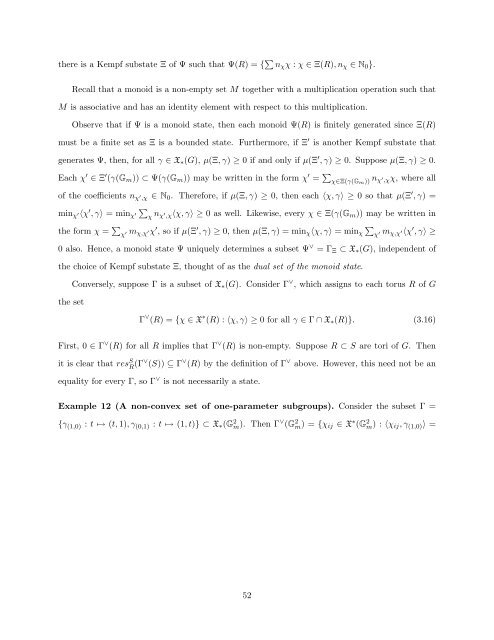Equivariant Embeddings of Algebraic Groups
Equivariant Embeddings of Algebraic Groups
Equivariant Embeddings of Algebraic Groups
Create successful ePaper yourself
Turn your PDF publications into a flip-book with our unique Google optimized e-Paper software.
there is a Kempf substate Ξ <strong>of</strong> Ψ such that Ψ(R) = { ∑ n χ χ : χ ∈ Ξ(R), n χ ∈ N 0 }.<br />
Recall that a monoid is a non-empty set M together with a multiplication operation such that<br />
M is associative and has an identity element with respect to this multiplication.<br />
Observe that if Ψ is a monoid state, then each monoid Ψ(R) is finitely generated since Ξ(R)<br />
must be a finite set as Ξ is a bounded state. Furthermore, if Ξ ′ is another Kempf substate that<br />
generates Ψ, then, for all γ ∈ X ∗ (G), µ(Ξ, γ) ≥ 0 if and only if µ(Ξ ′ , γ) ≥ 0. Suppose µ(Ξ, γ) ≥ 0.<br />
Each χ ′ ∈ Ξ ′ (γ(G m )) ⊂ Ψ(γ(G m )) may be written in the form χ ′ = ∑ χ∈Ξ(γ(G m)) n χ ′ ,χχ, where all<br />
<strong>of</strong> the coefficients n χ ′ ,χ ∈ N 0 . Therefore, if µ(Ξ, γ) ≥ 0, then each 〈χ, γ〉 ≥ 0 so that µ(Ξ ′ , γ) =<br />
min χ ′〈χ ′ ∑<br />
, γ〉 = min χ ′<br />
χ n χ ′ ,χ〈χ, γ〉 ≥ 0 as well. Likewise, every χ ∈ Ξ(γ(G m )) may be written in<br />
the form χ = ∑ χ ′ m χ,χ ′χ′ , so if µ(Ξ ′ , γ) ≥ 0, then µ(Ξ, γ) = min χ 〈χ, γ〉 = min χ<br />
∑χ ′ m χ,χ ′〈χ′ , γ〉 ≥<br />
0 also. Hence, a monoid state Ψ uniquely determines a subset Ψ ∨ = Γ Ξ ⊂ X ∗ (G), independent <strong>of</strong><br />
the choice <strong>of</strong> Kempf substate Ξ, thought <strong>of</strong> as the dual set <strong>of</strong> the monoid state.<br />
the set<br />
Conversely, suppose Γ is a subset <strong>of</strong> X ∗ (G). Consider Γ ∨ , which assigns to each torus R <strong>of</strong> G<br />
Γ ∨ (R) = {χ ∈ X ∗ (R) : 〈χ, γ〉 ≥ 0 for all γ ∈ Γ ∩ X ∗ (R)}. (3.16)<br />
First, 0 ∈ Γ ∨ (R) for all R implies that Γ ∨ (R) is non-empty. Suppose R ⊂ S are tori <strong>of</strong> G. Then<br />
it is clear that res S R (Γ∨ (S)) ⊆ Γ ∨ (R) by the definition <strong>of</strong> Γ ∨ above. However, this need not be an<br />
equality for every Γ, so Γ ∨ is not necessarily a state.<br />
Example 12 (A non-convex set <strong>of</strong> one-parameter subgroups). Consider the subset Γ =<br />
{γ (1,0) : t ↦→ (t, 1), γ (0,1) : t ↦→ (1, t)} ⊂ X ∗ (G 2 m). Then Γ ∨ (G 2 m) = {χ ij ∈ X ∗ (G 2 m) : 〈χ ij , γ (1,0) 〉 =<br />
52
















